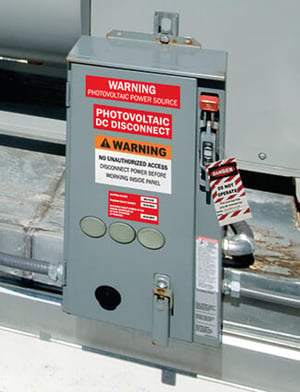NEMA Studies Switching Current in Buildings

Move over AC. It appears DC is on the verge of a comeback. Exploring the existing landscape and future scenarios for direct current (DC) in buildings, the National Electrical Manufacturers Association (NEMA) says it is documenting the impact of DC electrical distribution systems in commercial buildings as well as its role in electricity for the 21st century. Solar power systems typically produce DC, and digital equipment, computers, electric vehicles, and many other electric devices run on DC power, even though utilities and building circuitry have been designed for AC power distribution. Newer, technologies are making their way through industry in a variety of levels of electronic equipment. There are numerous benefits DC has on industry. However, NEMA says agencies should continue to discuss the entire system including insulation, ground, and various protections for safety.
Benefits of DC
"Insulating material has generally a much higher dielectric strength for DC when compared to AC," according to the International Electrotechnical Commission, the international standards and conformity assessment body for all fields of electrotechnology, who was involved in NEMA's study. "Moreover, there are substantial differences between DC and AC even with the same voltage; however, it is difficult to determine the exact and theoretical relationship between these two currents."
DC is more stable than AC, and this fact is one reason why there is a push to increase its use. As more digital technology becomes available to industry, DC could allow for better efforts to maintain a reliable, resilient, and secure electric grid across the country, supporters say. Companies are finding ways of using high voltage direct current to transport electricity long distances with less electricity loss, according to EMerge Alliance, an open industry association that supports DC adoption. As far as efficiency, EMerge Alliance estimates energy loss on the end-use side can reach 20% for some AC devices and with DC systems this can be reduced to 6% or lower.
"DC offers an ideal integrating platform for these modern power components; offering energy savings and improved reliability with potential for lower first cost," a group of scientists wrote for a Berkeley Lab study. "Furthermore, the efficiency, reliability, and ease of control of DC power distribution could be a low-cost element to achieving zero net energy (ZNE) buildings, thus helping California meet its ZNE and global climate change goals."
Studies conducted by IEEE and Los Alamos National Laboratory hold conservative perspectives. "IEEE estimates that DC distribution may improve efficiency of 3.4% for buildings without access to AC (e.g., islanded building with PV and storage installed), and only improve efficiency of 1.3% for buildings that have access to AC," said Brian Marchionini, senior program manager at NEMA. "Los Alamos National Laboratory estimates that DC distribution improves efficiency by 2-3% for buildings where the load and generation are well matched."
NEMA DCP 1-2018 Direct Current in Buildings summarizes the results of a survey with a variety of stakeholders, such as technical experts, laboratories, and standards development organizations among others. The report also highlights potential benefits of using DC in buildings in the next several years. Though, the efficiency improvement of using DC versus AC systems is still debatable.
"While some stakeholders are not convinced that DC is worth the investment, others are interested in proactively developing these systems," NEMA said. "Usage includes sources, storage, loads, circuits, and components."
DC Codes and Standards
 Awareness and acceptance of DC distribution systems could be enhanced with codes and standards updates, NEMA said in its report. There are various label elements necessary for compliance with the National Electric Code (NEC) and the National Fire Protection Association (NFPA) 70E. After all, DC still is energy, and working with energy has its hazards. Already, there are numerous references to DC circuits, labeling of DC conductors, and more, in many articles of the National Electric Code and the 2020 revision. Some examples include Article 393 ? Low Voltage Suspended Ceiling Power Distribution Systems; Article 411 ? Low Voltage Lighting; and Article 480 ? Storage Batteries.
Awareness and acceptance of DC distribution systems could be enhanced with codes and standards updates, NEMA said in its report. There are various label elements necessary for compliance with the National Electric Code (NEC) and the National Fire Protection Association (NFPA) 70E. After all, DC still is energy, and working with energy has its hazards. Already, there are numerous references to DC circuits, labeling of DC conductors, and more, in many articles of the National Electric Code and the 2020 revision. Some examples include Article 393 ? Low Voltage Suspended Ceiling Power Distribution Systems; Article 411 ? Low Voltage Lighting; and Article 480 ? Storage Batteries.
By partnering with industry and government organizations, NEMA said it can accelerate awareness, acceptance, and deployment of DC distribution systems in buildings. NEMA published a separate report on DC Power Distribution in Buildings: A Review of Codes and Standards that is available to its members. Non-members will have the opportunity to purchase this soon, Marchionini said.
Meanwhile, the International Code Council (ICC) is working on nearly 1,200 code change proposals that effect nearly every sector of the electroindustry. While public comment is still being gathered for emergency lighting and control systems, the 2021 I-Code is set for publication in late 2020.
Related Resources

5 Solar Installation Best Practices You Need to Know
Installing solar panels can be more complex than you think. There are numerous factors to take into account ...
Read
Available Fault Current
The National Electric Code, or NEC, requires that equipment be marked with the available fault current, and ...
Read
Stop Electrical Explosions Before They Start with Circuit Analysis
What Causes an Arc Blast? Electricity powers nearly every industrial process—but when something goes wrong, ...
Read.png)





